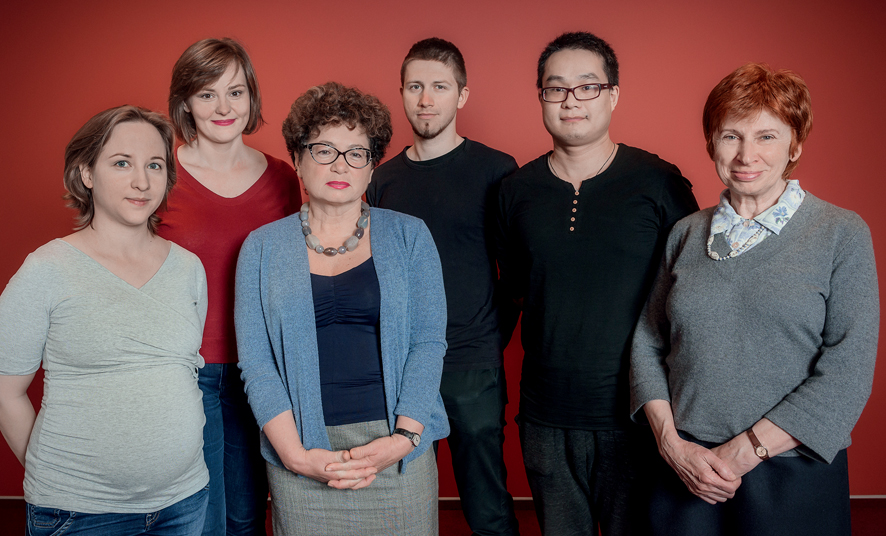Head of laboratory

Research profile
Injury of the CNS alters transcriptional programs that determine neuronal fate: survival and recovery, or death. A powerful pro-survival/recovery program in neurons and glial cells may be triggered by neurotrophic factors. We focus on neurotrophins, their receptors, and related molecules; assuming that their selective regulation may limit signaling through pro-apoptotic pathways and promote recovery processes. To modulate their expression after spinal cord injury; locomotor exercise, electrical stimulation of the peripheral nerves and tissue transduction with AAV-carried transgenes are in use. These treatments cause remodeling of the spinal network and lead to functional improvement. We search for the mechanisms of neurotrophic regulation of neurotransmission in motoneurons and at the neuro-muscular junction. Contribution of extracellular matrix proteoglycans and postsynaptic excitatory and inhibitory receptors are in focus.
Advanced immunohistochemistry combined with wide field and confocal microscopy are used to study architecture and activation of neuronal networks. Neuronal, dendritic and axonal tracing supported by immunolabeling, DNA/RNA staining and histological identification of myelin and glia are used to examine morphological changes and localization of specific proteins in single cells and synapses. Tissue sampling and Laser Capture Microdissection of single cells are used to identify local changes in gene and protein expression with the use of RT PCR, ELISA, and Western blotting. Behavioral and electrophysiological setups provide data on animal kinematics during locomotion.
For further information visit: http://restorativeneurobiology.nencki.edu.pl
Current research activities
- potential of AAV-mediated BDNF transgene overexpression in early responses of excitatory and inhibitory neurotransmitter systems in the transected spinal cord: assessment of contribution of pre-and postsynaptic molecules to altered signaling to motoneurons and at neuro-muscular junctions
- the reorganization of synaptic input to the ankle flexor and extensor motoneurons induced by chronic electrical stimulation of proprioceptive fibers in rats after complete transection of the spinal cord
- the role of extracellular matrix and perineuronal nets surrounding motoneurons in the spontaneous recovery processes in the transected spinal cord: modulation by locomotor exercise and electrical stimulation of proprioceptive fibers
Selected publications
Gajewska-Woźniak O., Grycz K., Czarkowska-Bauch J., Skup M. (2016) Electrical Stimulation of Low-Threshold Proprioceptive Fibers in the Adult Rat Increases Density of Glutamatergic and Cholinergic Terminals on Ankle Extensor α-Motoneurons. PLoS One, 11(8): e0161614.
Wójcik-Gryciuk A., Skup M., Waleszczyk W.J. (2015) Glaucoma – state of the art and perspectives on treatment. Restor Neurol Neurosci, 34: 107-123.
Ziemlińska E., Kügler S., Schachner M., Wewiór I., Czarkowska-Bauch J., Skup M. (2014) Overexpression of BDNF Increases Excitability of the Lumbar Spinal Network and Leads to Robust Early Locomotor Recovery in Completely Spinalized Rats. PLoS One, 9(2): e88833.
Gajewska-Woźniak O., Skup M., Kasicki S., Ziemlińska E., Czarkowska-Bauch J. (2013) Enhancing proprioceptive input to motoneurons differentially affects expression of neurotrophin 3 and brain-derived neurotrophic factor in rat hoffmann-reflex circuitry. PLoS One, 8(6):e65937.
Skup M., Gajewska-Wozniak O., Grygielewicz P., Mankovskaya T., Czarkowska-Bauch J. (2012) Different effects of spinalization and locomotor training of spinal animals on cholinergic innervation of the soleus and tibialis anterior motoneurons. Eur J Neurosci, 36(5): 2679-2688.

